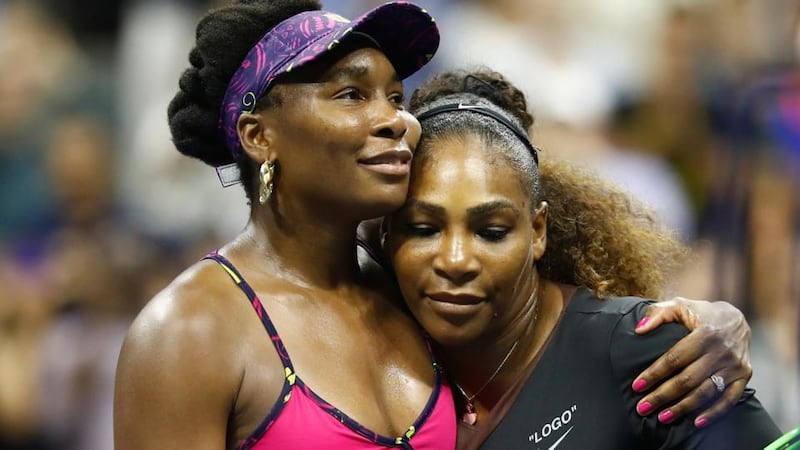For the first time in her career and maybe the last time in her life, Serena Williams walked on to Centre Court on Tuesday evening and the cheering was sympathetic, encouraging, a softening of feeling towards the best women’s tennis player in the history of the sport.
It sensed the 40-year-old champion, who had not played a competitive match in over a year, could not just rock up and turn the tennis world inside out. Tiger Woods was 43 years-old when he won his last Masters in 2019. But tennis isn’t golf.
Vulnerable Williams rarely drew that kind of affection before. Hers was a ferocious brand of competitive spirit. Praise was for her incredible physique, on-court vim and zest to win. The greatest sister act in the history of the game, maybe sport, seemed always to draw considered, qualified praise.
Fox Sports came up with an image when it compared her backside to “an oozing pumpkin”. The Daily Telegraph couldn’t help itself in the degradation and went one better writing that her “breasts were registered to vote in a different US state from the rest of her”.
“The cycles of poverty, discrimination and sexism,” she wrote in 2018, “are much, much harder to break than the record for Grand Slam titles.”
Williams had to survive in a tennis world where there was often respect and fear of her tennis game but little sympathy, or empathy about what and where she had come from, what her daily life was like leaning into headwinds of racism and casual misogyny.
For that she needed her own suit of armour and part of that was a distance she sometimes kept from the locker room. That was often made easy. In 2001, when Serena was 20, Grand Slam winner Martina Hingis asserted from the seat of white European privilege, that being black was an advantage in tennis and drew preferential treatment.
At the 2001 BNP Paribas Open tournament in Indian Wells, California, Serena and Venus were booed by fans who accused them of match fixing when Venus withdrew from a scheduled semi-final match.

“When Venus and I were walking down the stairs to our seats, people kept calling me ‘n****r”, her father and coach Richard Williams told USA Today at the time. One man, he said, threatened, “’I wish it was ‘75; we’d skin you alive.’”
Serena boycotted the event for more than a decade, only returning in 2015.
Part of the carapace was that, in defeat, Serena would say or imply that she lost because of her own failings not to live up to a set of standards that only she and perhaps Venus could ever reach. Serena was always beaten by herself not her opponent. Generally, that was true. But it didn’t wash with Wimbledon crowds that feed off matters of the heart.
Give them a no-hoper and they shriek with delight, a sob story and they pull her to their bosom, a “Corry” storyline and they beg for an omnibus two-week series.
Instead, the sisters were accused of fixing games on their father Richard’s instruction and being unfriendly. In an interview with Harper’s Bazaar in 2018, Williams wore a jacket that said: “Queen. Don’t be afraid to rule like a king.” During the interview she explained why she was moved to write an open letter to her mother thanking her for support over being accused of being a man.
“People would say I was born a guy, all because of my arms, or because I’m strong,” she told the magazine. “I was different from Venus. She was thin and tall and beautiful, and I am strong and muscular – and beautiful, but, you know, it was just totally different.”
The Williamses had all of the storylines. They had the poverty, the discrimination, the countercultural victory over an establishment, white sport. Serena obliterated the system, yet she and her sister were never fully loved like Roger Federer or Rafa Nadal.
She was always quietly fighting something. Even this week, a study by the Press Association showed Wimbledon’s Centre Court as the only one of the four main Grand Slam show courts that continues to see more men’s than women’s matches. None of the previous 10 Wimbledon championships have seen an equal number of men’s and women’s singles matches on Centre Court, averaging 55 per cent on the men’s side.
Harmony Tan, the 24-year-old debutant ranked 115th, who beat Williams in only her third first-round defeat ever in hundreds of Grand Slam matches is the type of player Williams used to beat before even stepping on court. But the so-derided athletic frame that carried Williams to so much success requires an engine room that just isn’t there any more. Winning takes a toll and it is not just her 23 Slams.
Serena has 16 Grand Slam doubles titles, as well as 319 weeks spent at the top of the world rankings across 15 years, the longest stretch 186 weeks in a row. She won the “Serena Slam” in 2002-03, all four Majors back-to-back, then repeated it in 2014-15. She has four Olympic gold medals and is also the oldest woman to be ranked number one in the world.
Afterward the Wimbledon defeat, she was vague about the future. But in a circular way it has ended how it started. This week aside, she began beating players twice her age and ended beating players half her age.

















